Last Updated on July 1, 2025 by Lucas
Ever craved sushi rolls but thought they were too tricky to make at home? With just a few simple ingredients like sushi rice, nori sheets, and your favorite fillings, you can roll up a restaurant-worthy bite in just 25 minutes. Whether you’re a beginner or just short on time, this easy sushi roll recipe is the perfect way to get creative in your kitchen—and impress everyone at the table.
Key Benefits of Making Sushi Rolls at Home
Discover why crafting sushi rolls in your own kitchen is both fun and rewarding:
Quick, Budget‑Friendly, and Delicious
Making sushi roll recipes yourself saves you time and money. With just 25 minutes, you can whip up a fresh, restaurant-quality roll that costs less than takeout. Plus, cooking at home means you control the flavor—no hidden sugars or oily sauces.
Customizable for Any Dietary Preference
You get to pick what goes inside:
- Lean protein like smoked salmon or tofu
- Veggies such as avocado, cucumber, or bell peppers
- Optional extras like cream cheese, sesame seeds, or spicy mayo
Whether you’re vegan, gluten-free, or craving a California or Philadelphia–style sushi, you have full creative freedom.
No Special Equipment Needed (Yes, You Can Skip the Mat!)
Think you need a bamboo mat? Not at all.
- Use plastic wrap or parchment if you don’t have a makisu.
- A simple bowl, sharp knife, and nori sheets are all it takes.
This makes it perfect for smaller kitchens or quick weekday cooking.
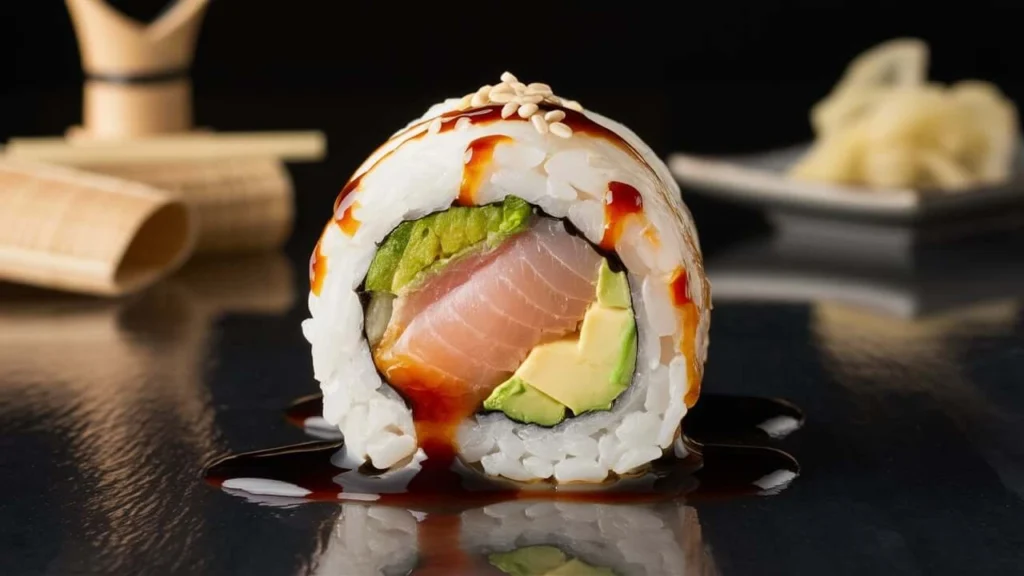
Great for Impressing Guests or Family
Homemade sushi is surprisingly impressive—plus you’re the chef.
- Ideal for casual dinner parties,
- A fun date-night activity,
- Or a creative way to get kids excited about cooking.
When you plate your rolls with pickled ginger, soy sauce, and wasabi, it looks like a photo-worthy restaurant spread.
Each tip adds value, highlights benefits, and naturally includes keywords like sushi roll, sushi roll recipes, nori sheets, and spicy mayo, while keeping sentences concise and reader-friendly.
Ingredients You’ll Need for the Perfect Sushi Roll
Below is a clear breakdown of essentials, fillings, optional add-ons, and tools for your sushi roll recipe:
| Category | Items |
| Essential Ingredients | Sushi rice, nori sheets, rice vinegar, soy sauce |
| Popular Fillings | Imitation crab, avocado, cucumber, smoked salmon, cream cheese |
| Optional Add‑Ons | Pickled ginger, wasabi, sesame seeds, spicy mayo |
| Tools to Have On Hand | Bamboo sushi mat (or plastic wrap alternative), sharp knife, rice paddle |
Why each matters
- Sushi rice + rice vinegar give that classic sticky, tangy base—plus acidified rice helps prevent harmful bacteria when cooled properly.
- Nori sheets wrap everything neatly, giving you a satisfying bite every time.
- Soy sauce adds just the right dose of umami.
- Popular fillings let you play around—whether you’re craving California rolls or Philadelphia-style sushi.
- Optional add‑ons like spicy mayo or sesame seeds bring texture and flavor variety.
- Don’t stress about fancy gear—plastic wrap works fine if you don’t have a bamboo mat. And a sharp knife and rice paddle make rolling clean and easy.
This setup emphasizes clarity, visual readability, and helpful SEO keywords like sushi rice, nori sheets, and spicy mayo, while maintaining a friendly voice. Let me know when you’d like to move on to the Instructions section.
Step-by-Step Instructions: Sushi in Just 25 Minutes
Mastering an easy sushi recipe is about steady pace, simple steps, and a little practice. You’ve got this—let’s roll.
Step 1 – Prepare the Sushi Rice
- Rinse 1 cup of sushi rice until the water runs clear.
- Cook with equal parts water (1:1 ratio).
- While still warm, fold in 2 tbsp rice vinegar, 1 tsp sugar, and a pinch of salt.
- Use a wooden paddle or spoon to gently fluff and cool.
- The vinegar raises acidity, keeping rice safe at room temperature by lowering pH below 4.6 .
Step 2 – Lay Out the Nori and Add Fillings
- Place one nori sheet, shiny side down, on your mat (or plastic wrap).
- Wet your fingers—this keeps rice from sticking.
- Spread ~½ cup of rice, leaving a 1 inch border at the top.
- Add your fillings in a line across the center (e.g., imitation crab, avocado, cucumber).
Step 3 – Roll It Tight Without Tearing
- Lift the mat’s edge closest to you.
- Begin rolling away from you, tucking fillings in.
- Press gently but firmly to create a compact roll.
- Continue rolling until the nori closes, then seal with damp fingers.
- Using a bamboo mat or plastic‑wrapped towel helps shape the roll neatly .
Step 4 – Slice and Serve Like a Pro
- Transfer roll to a cutting board.
- Dip a sharp knife in vinegar water (to prevent sticking).
- Cut into 6–8 even pieces using a gentle sawing motion.
- Wipe the blade between cuts for clean edges.
- Arrange on a platter with soy sauce, wasabi, and pickled ginger.
With these how to roll sushi steps, you’ll create a tight, flavorful roll in just 25 minutes. Next, let’s explore Pro Tips and Variations so you can add your own twist.
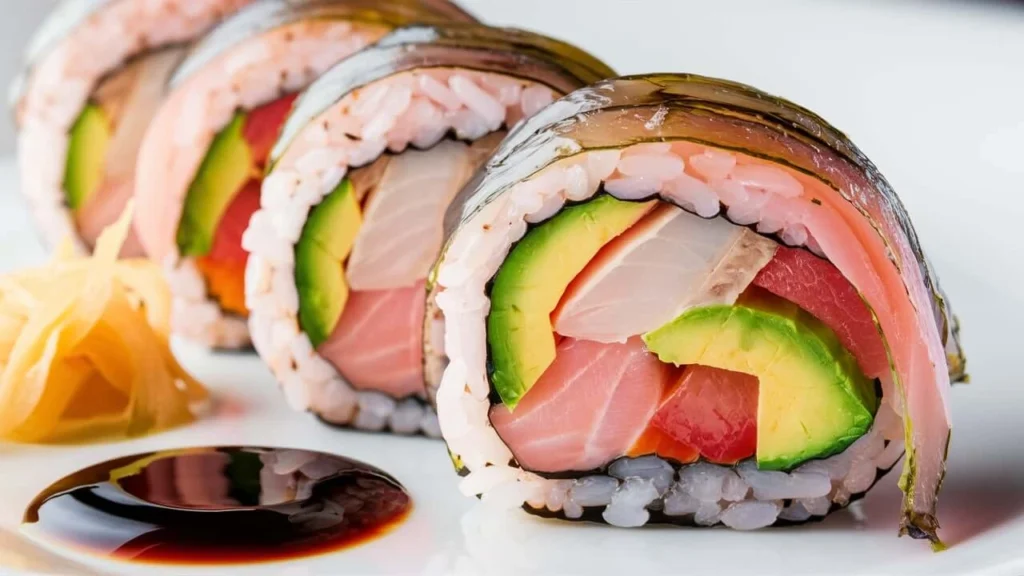
Pro Tips and Fun Variations
Here are practical tips and creative ideas to help you elevate your sushi roll game:
Don’t Overfill – Less is More
- Use just a thin layer of rice on the nori—this keeps the roll tidy and easy to slice.
- Add 1–2 fillings max to avoid bursting rolls.
- Test a small bite first, then adjust the amount.
This helps your roll stay tight and keeps those ingredients balanced.
Use Plastic Wrap if You Don’t Have a Bamboo Mat
- Lay down a sheet of plastic wrap on the counter.
- Place nori, rice, and fillings on top.
- Use the wrap to help you roll—keep pressure even and gentle.
This trick gives you structured, tight rolls without special gear.
Try a Spicy Tuna or Vegetarian Roll Twist
- For spicy tuna, mix canned tuna or sashimi-grade tuna with a dash of sriracha or spicy mayo.
- For vegetarian rolls, go bold with avocado, cucumber, bell pepper, and tofu or tempura veggies.
- Add sesame seeds or thin strips of carrot for texture and color.
These variations let you personalize your easy sushi recipe and cater to all preferences.
Add Sesame Seeds or Tempura Crunch for Texture
- Sprinkle black or white sesame seeds on the rice before rolling.
- Roll in crispy tempura bits for crunch.
- Drizzle with spicy mayo or unagi sauce after slicing for that restaurant feel.
These small additions turn a simple roll into something truly special.
With these pro tips and sushi roll variations, you’ll cook smarter and more creatively. Try one, or mix and match to suit your taste. Next, let’s move on to serving suggestions for the perfect sushi experience.
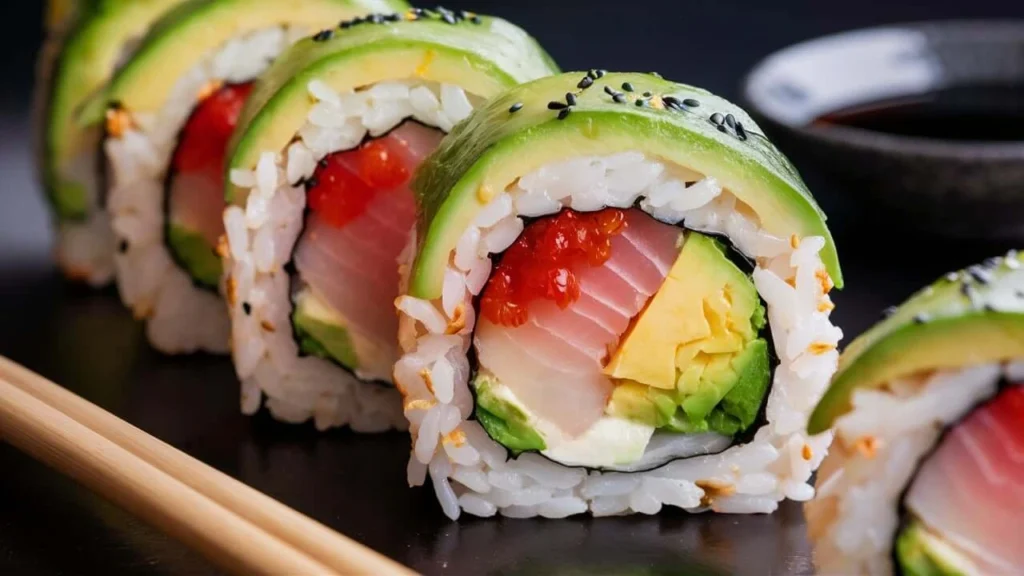
Serving Suggestions for Your Homemade Sushi
Serving your homemade sushi rolls is an opportunity to elevate the dining experience, making it both visually appealing and flavorful. Here are some thoughtful ideas to complement your sushi rolls:
Serve with Soy Sauce, Wasabi, and Pickled Ginger
- Soy Sauce: A classic accompaniment, soy sauce enhances the umami flavor of your sushi. Remember, it’s best to dip the fish side of the sushi into the soy sauce, avoiding the rice to prevent it from becoming soggy.
- Wasabi: Traditionally, a small amount of wasabi is placed between the fish and rice by the sushi chef. If you prefer more heat, add a dab directly to your sushi.
- Pickled Ginger: Ginger serves as a palate cleanser between different types of sushi, allowing you to fully appreciate the distinct flavors of each variety.
Plate with a Side of Miso Soup or Seaweed Salad
- Miso Soup: A warm bowl of miso soup complements sushi perfectly. It typically contains dashi stock, silken tofu, seaweed, and scallions, offering a comforting and savory side.
- Seaweed Salad: A refreshing seaweed salad dressed with dashi, rice vinegar, soy sauce, and sesame oil adds a delightful contrast to the richness of sushi rolls.
Sushi Platter Ideas for Parties or Date Nights
Creating a sushi platter can be a fun and interactive way to enjoy sushi with others:
- Variety: Include a mix of rolls, such as California rolls, spicy tuna rolls, and vegetarian options, to cater to diverse tastes.
- Arrangement: Arrange the sushi rolls neatly on a platter, garnished with slices of pickled ginger and small bowls of soy sauce for dipping.
- Additional Sides: Incorporate sides like edamame, tempura vegetables, or rice balls to provide a well-rounded meal.
Fun Dipping Sauces: Spicy Mayo or Ponzu
Enhance the flavor profile of your sushi rolls with these dipping sauces:
- Spicy Mayo: A creamy and spicy sauce made by mixing mayonnaise with sriracha sauce. It adds a rich, tangy kick to your sushi.
- Ponzu Sauce: A citrus-based soy sauce that offers a tangy and slightly sweet flavor, providing a refreshing contrast to the savory taste of the sushi.
Experimenting with these sauces can add a personalized touch to your sushi experience.
By thoughtfully pairing your homemade sushi rolls with these sides and sauces, you can create a dining experience that is both satisfying and memorable.
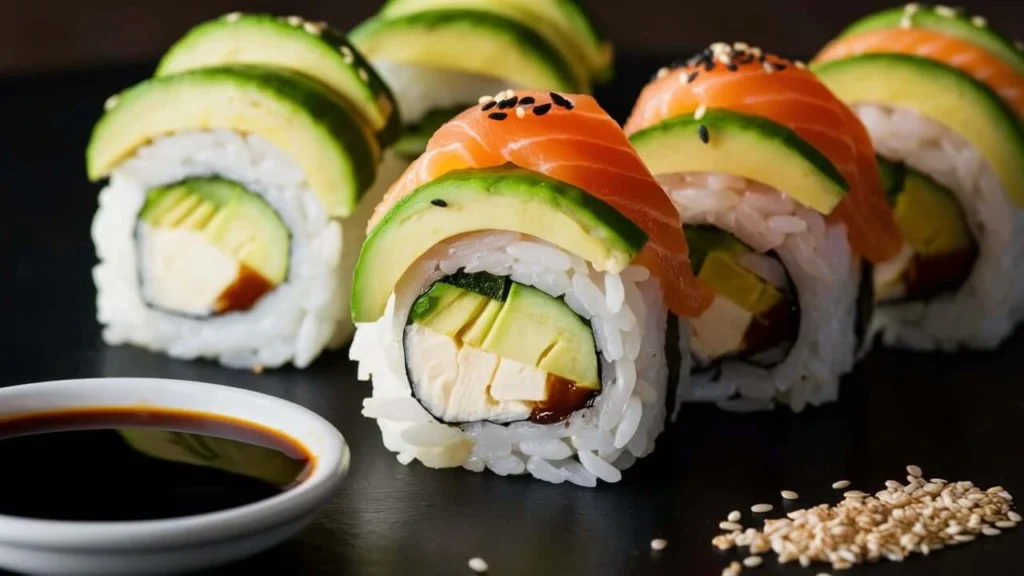
Conclusion
Making sushi rolls at home is not only achievable but also incredibly rewarding. In just 25 minutes, you can enjoy fresh, flavorful sushi tailored to your taste. Don’t hesitate to share your creations or any tips you’ve discovered in the comments below. Your experiences can inspire others to embark on their own sushi-making journey. Once you’ve mastered this basic roll, consider experimenting with different fillings and flavors to create your own signature sushi rolls. The possibilities are endless, and the adventure is yours to enjoy. Happy rolling.
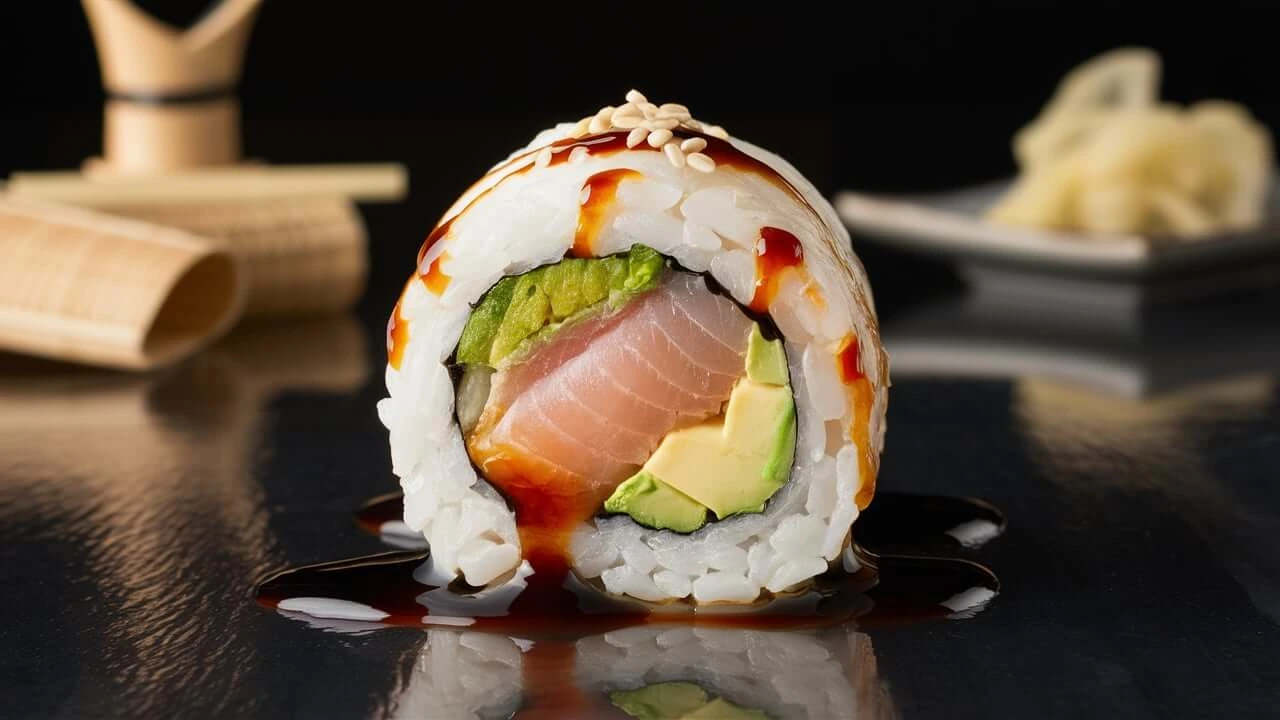
Learn how to make sushi rolls in just 25 minutes
Equipment
- Bamboo Sushi Mat Helps roll sushi tightly and evenly.
- Sharp Knife Ensures clean, precise cuts for your rolls.
- Rice Paddle/Spoon Makes it easy to handle sticky sushi rice.
Ingredients
- 2 cups sushi rice
- 2½ cups water
- 2 tbsp rice vinegar
- 1 tbsp sugar
- ½ tsp salt
- 4 sheets nori seaweed
- 1 cucumber julienned
- 1 avocado sliced
- 4 oz smoked salmon thinly sliced
- Soy sauce for dipping
- Pickled ginger for serving
- Wasabi optional
Instructions
Prepare the Sushi Rice:
- o Rinse the sushi rice under cold water until the water runs clear.
- o Combine the rice and water in a saucepan. Bring to a boil, then reduce heat to low, cover, and simmer for 10 minutes.
- o Remove from heat and let it sit, covered, for 10 minutes.
- o In a small bowl, mix the rice vinegar, sugar, and salt until dissolved. Gently fold this mixture into the cooked rice. Let the rice cool to room temperature.
Assemble the Sushi Rolls:
- o Place a sheet of nori on a bamboo sushi mat, shiny side down.
- o With wet hands, spread a thin layer of sushi rice over the nori, leaving a 1-inch border at the top.
- o Arrange a few slices of cucumber, avocado, and smoked salmon along the center of the rice.
- o Carefully lift the edge of the mat closest to you and roll the sushi away from you, pressing gently to keep the roll tight.
- o Seal the edge with a little water.
Slice and Serve:
- o Using a sharp knife dipped in water, slice the roll into 6-8 pieces.
- o Serve with soy sauce, pickled ginger, and wasabi on the side.
Notes
- Calories: Approximately 200 kcal
- Protein: 6g
- Carbohydrates: 30g
- Fat: 5g
- Sodium: 300mg
- Fiber: 3g
FAQs
Can I make sushi rolls without raw fish?
Absolutely. Many sushi rolls are made with cooked ingredients. Popular options include California rolls with imitation crab, avocado, and cucumber, as well as rolls featuring cooked shrimp, smoked salmon, or even grilled vegetables. These variations are both delicious and safe for those who prefer to avoid raw fish.
What can I use instead of a sushi rolling mat?
If you don’t have a bamboo sushi mat, don’t worry. You can use parchment paper, plastic wrap, or even a clean kitchen towel as a substitute. These alternatives can help you roll your sushi effectively.
How do I keep sushi rolls from falling apart?
To prevent your sushi rolls from falling apart, ensure you use short-grain sushi rice, as it sticks better than long-grain rice. Additionally, when slicing the rolls, use a sharp knife and clean it between cuts to maintain clean edges. If a roll is loose, you can reinforce it by wrapping a small strip of dampened nori around the outside.
Is homemade sushi healthier than restaurant sushi?
Homemade sushi can be a healthier option as you have control over the ingredients and portion sizes. By choosing fresh, high-quality ingredients and limiting the use of sauces high in sugar or sodium, you can create a nutritious meal. However, it’s important to note that some sushi rolls, especially those with fried components or heavy sauces, can be high in calories.[1]
What are sushi rolls called?
Sushi rolls are commonly referred to as “maki” in Japanese. This term encompasses various types of rolls, including:
Hosomaki: Small rolls with a single filling.
Uramaki: Inside-out rolls with rice on the outside.
Futomaki: Thicker rolls with multiple fillings.
These rolls are typically made by rolling ingredients in seaweed (nori) and slicing them into bite-sized pieces.
What are the top 10 sushi rolls?
While preferences vary, some of the most popular sushi rolls include:
California Roll
Spicy Tuna Roll
Philadelphia Roll
Dragon Roll
Rainbow Roll
Shrimp Tempura Roll
Eel Avocado Roll
Volcano Roll
Crunchy Roll
Spider Roll
These rolls are beloved for their unique combinations of flavors and textures.
What is considered one sushi roll?
One sushi roll typically refers to a full roll that is sliced into several pieces. For instance, a standard maki roll is usually cut into 6 to 8 pieces. The number of pieces can vary depending on the size of the roll and personal preference.
Is a sushi roll 6 pieces?
Yes, a standard sushi roll is commonly sliced into 6 pieces. However, some rolls may be cut into 8 pieces, especially if they are larger or contain multiple fillings. The number of pieces can vary based on the restaurant or personal preference.
Feel free to ask if you have more questions or need further assistance with your sushi-making journey.

3 thoughts on “Sushi Roll Obsession: Make This In Just 25 Minutes”